Key Takeaways:
- Family history is a risk factor for breast cancer. Your chances of getting breast cancer involve a complex interplay between genetic factors, like BRCA1 and BRCA2 mutations, and environmental influences such as lifestyle and exposure to toxins.
- Genetic testing and counseling may help. They provide crucial insights into hereditary risks and guide personalized screening and prevention strategies.
- Some breast cancer cases are preventable. Measures such as lifestyle adjustments and regular screenings can significantly reduce breast cancer risk, particularly when tailored to individual profiles.
Breast cancer is one of the most common1 types of cancer in women, accounting for around 30% of total female cancer diagnoses every year. Understanding its origins is a critical step toward prevention and early intervention.
The answer isn’t a simple binary to unpack. Like many diseases, breast cancer exists at the intersection of genetics and other factors. However, one thing is clear: knowing your risk matters in early detection and prevention, and genetics play a role in your overall risk.
Catch demystifies cancer risk through personalized assessments and action plans. We evaluate individual risk factors for 21 major cancers, including breast cancer, and craft tailored strategies for prevention. Whether you’re worried about a family history of breast cancer or the impact of environmental exposures, the question of heredity versus environment is one we confront head-on.

The Role Of Family History In Breast Cancer Risk
It's widely acknowledged that a familial pattern of breast cancer can raise your risk of developing the condition. According to information from the American Cancer Society[2], having a first-degree relative (mother, sister, or daughter) with breast cancer almost doubles your risk. Having two first-degree relatives means your risk is about three times as high. Genes certainly play a central role in this dynamic.
How is breast cancer inherited? Certain inherited genetic mutations, most notably those in the BRCA1 and BRCA2 genes, have been linked to an increased likelihood of breast cancer. About 5-10% of all breast cancer cases are said to be hereditary, meaning that they’re linked to gene changes like these. If you’re a carrier of these genes, your chance of developing the disease by the time you are 80 years old is as high as 70%.
Note that not everyone with a predisposition will ultimately develop breast cancer. Conversely, many individuals with no known family history will. Nevertheless, the correlation between family history and breast cancer cannot be dismissed. This vigilance is crucial for early detection, effective treatment, and favorable outcomes.
Finding Out Whether You’re At An Increased Risk Of Breast Cancer With Genetic Testing
Genetic testing can clarify whether early screenings are necessary and whether you are suitable for specific preventive measures. If your loved one who has had breast cancer is living and able, it is ideal that they get genetic testing, as it can provide insight for you and other blood relatives who may be at risk. You can also go through genetic testing for genes associated with breast cancer3 yourself.
Usually, the process involves a simple blood test. Once you receive the results, a medical provider can review them with you and discuss the next steps. For those with a family history of breast cancer, it is advisable to discuss personal risk factors with a healthcare provider. Together, you can develop a tailored plan to manage and mitigate potential risks.
The potential downside of genetic testing is that these tests can be financially inaccessible for some people. Insurance may not cover genetic testing if you don’t have a strong family history. However, it is valuable if it is something within your reach.
Environmental Factors And Breast Cancer Development
Like genetics, certain environmental exposures are risk factors for breast cancer, either directly affecting breast tissue or by disrupting the body's hormonal balance, which can promote cancer growth. Here's a closer look:
- Chemical Exposures: Exposure to certain chemicals, particularly those that possess estrogen-like properties known as endocrine disruptors, can potentially increase breast cancer risk. Common examples include bisphenol A (BPA) in some plastics, pesticides such as DDT, and industrial chemicals like polychlorinated biphenyls (PCBs).
- Excess Radiation Exposure: Radiation can increase breast cancer risk. This includes exposure from medical purposes, such as CT scans and X-rays, although the risk from these procedures is generally low and should be weighed against their medical necessity.
- Air Pollution: Recent studies suggest a possible link between air pollution and breast cancer. Certain pollutants may act as endocrine disruptors or carcinogens that can initiate or promote the development of cancer.
- Occupational Hazards: Women working in industries with higher exposures to carcinogens and endocrine-disrupting chemicals, such as the plastic, textile, beauty, or agricultural sectors, may have an increased breast cancer risk compared to other populations.
- Light at Night: Exposure to light at night can disrupt circadian rhythms and suppress melatonin production, a hormone that protects against cancer. The International Agency for Research on Cancer (IARC) has classified night shift work as a probable carcinogen.
Mitigating environmental exposures can be complex, as not all are within your control. However, there are steps you can take, like choosing products without BPA, reducing alcohol consumption, and advocating for policies that reduce public exposure to known carcinogens.

Preventive Measures And Screening Guidelines
There are preventative measures you can take to lower your risk of breast cancer. The right suggestions for you will differ, but may include:
- Regular Exercise: At least 150-300 minutes of moderate physical activity each week. Exercise is correlated with a reduction in the risk of various cancers, including breast cancer.
- Balanced Diet: The cancer prevention diet focuses on limiting processed foods and restricting alcohol intake to no more than one drink per day to minimize risk factors associated with diet. Some foods, like produce, can be protective.
- Limit Environmental Exposures: Where possible, reduce exposure to known carcinogens like pesticides and certain plastics, as well as unnecessary radiation.
- Consultation for Hereditary Risks: If you are at high risk due to family history, work with a genetic counselor to create a personalized prevention plan that may include more frequent screenings or preventive treatments.
- Review Hormonal Treatments: Discuss the risks and benefits of hormone replacement therapy or oral contraceptives with your healthcare provider, as these can slightly elevate breast cancer risk. Hormonal interventions, like tamoxifen or raloxifene, are options for high-risk individuals, but they come with side effects and aren’t a one-size-fits-all solution.
- Self-Exams: Self-exams and clinical breast exams, while not substitutes for imaging, are still necessary and can play a role in noticing early signs of breast cancer. You likely get clinical breast exams during your annual check-up with your gynecologist.
- Mammograms: For women at average risk, the American Cancer Society suggests starting annual mammograms at age 45, with the option to switch to biennial screening at 55. Those with a family history or known genetic mutations, like BRCA1 or BRCA2, may need to start younger (in their 20s or 30s) and incorporate MRI scans alongside mammograms.
- Preventative Surgery: Prophylactic surgeries (such as a double mastectomy) are on the table for those with significant genetic predispositions, though these are deeply personal decisions requiring thorough medical consultation.
The bottom line? Risk reduction and early detection hinge on personal choices and medical vigilance. Consult with your doctor to determine what steps you should take to learn how to prevent cancer with an individualized approach.
Take Control of Your Cancer Risk With Catch
At Catch, we arm you with the data and tools you need to face your cancer risk head-on. Our platform offers personalized risk assessments for 21 major cancers, including breast cancer, cutting through the noise to focus on what matters: your unique profile.
Why choose Catch? We deliver:
- Tailored Risk Assessments: We analyze your genetic, lifestyle, and environmental factors to pinpoint your specific risks.
- Actionable Plans: Get customized screening schedules and lifestyle interventions to lower your risk.
- Digestible Insights: Stay informed with summaries of the latest cancer research, translated into clear, easy-to-understand language.
Don’t wait for warning signs. Become a Catch member for just $5/month and take the first step toward managing your cancer risk. Sign up today for a personalized plan that puts you in control.

Final Thoughts
Is breast cancer genetic? It can be. The data is clear; genetic mutations like BRCA1 and BRCA2 can significantly elevate risk, with some carriers facing up to a 70% chance of developing the disease. Yet, environment and lifestyle often play an equally critical role in shaping outcomes, from exposure to pollutants to diet and exercise habits. The reality is, no one’s risk is set in stone.
At Catch, we offer personalized cancer risk assessments, diving deep into your unique genetic and lifestyle factors for 21 major cancers, including breast cancer. With access to the latest research summaries and a mission to support everyone, including sponsored memberships for those in need, we’re here to guide you. Become a member now to get your action plan and take control.
Read also:
Frequently Asked Questions About Hereditary And Environmental Risk Factors For Breast Cancer
Are BRCA1 and BRCA2 mutations the only genetic factors associated with breast cancer?
No. While BRCA1 and BRCA2 are the most well-known genetic mutations associated with breast cancer, other genes like PALB2, CHEK2, and ATM also contribute to increased risk, leading to the need for screening strategies[4], such as checking for breast cancer at a younger age.
Does breast cancer run in families?
Breast cancer can run in families, and family history is a known risk factor. That said, many factors can influence your cancer risk. If you have a family member who has had breast cancer, it does not necessarily mean that you will also develop the disease.
Is it possible to prevent hereditary breast cancer?
While hereditary breast cancer cannot be entirely prevented, the risk can be managed through strategies like early screenings and lifestyle changes. In some high-risk cases, preventive surgeries or medications may be recommended.
How do hormones affect breast cancer risk?
Yes. Hormones, particularly estrogen and progesterone, can influence breast cancer risk. Prolonged exposure to estrogen (through early menstruation, late menopause, or hormone replacement therapy) can increase risk. Hormonal factors often interact with genetic and environmental elements.
How is hereditary breast cancer diagnosed?
Hereditary breast cancer is diagnosed through a combination of family history evaluation, genetic testing for specific mutations, and clinical assessments. If a mutation is identified, it confirms a hereditary risk, though not necessarily the presence of cancer. Diagnosis of the disease requires imaging, biopsies, and other medical tests.
How does age affect breast cancer risk?
Most breast cancer cases occur in women aged 50+, hence the connection between menopause and breast cancer. Like genetics, age is a factor you can’t control, but there are still things you can do to prevent cancer.
How often should someone with a family history of breast cancer get screened?
Screening frequency depends on individual risk factors, including family history and genetic test results. For those at risk of premenopausal breast cancer, annual mammograms or MRIs starting at a younger age (often 25-30) may be recommended, along with clinical breast exams.
Sources:
- American Cancer Society. (n.d.). Breast Cancer Statistics. https://www.cancer.org/cancer/types/breast-cancer/about/how-common-is-breast-cancer.html
- American Cancer Society. (n.d.). Breast Cancer Risk Factors You Can’t Change. https://www.cancer.org/cancer/types/breast-cancer/risk-and-prevention/breast-cancer-risk-factors-you-cannot-change.html
- U.S. National Library of Medicine. (n.d.). BRCA1 and BRCA2 gene testing: MedlinePlus medical encyclopedia. MedlinePlus. https://medlineplus.gov/ency/patientinstructions/000690.htm
- Lowry KP, et al. (n.d.). Breast cancer screening strategies for women with ATM, CHEK2, and PALB2 pathogenic variants: A comparative modeling analysis. JAMA Oncology. https://pubmed.ncbi.nlm.nih.gov/35175286/










.svg)



